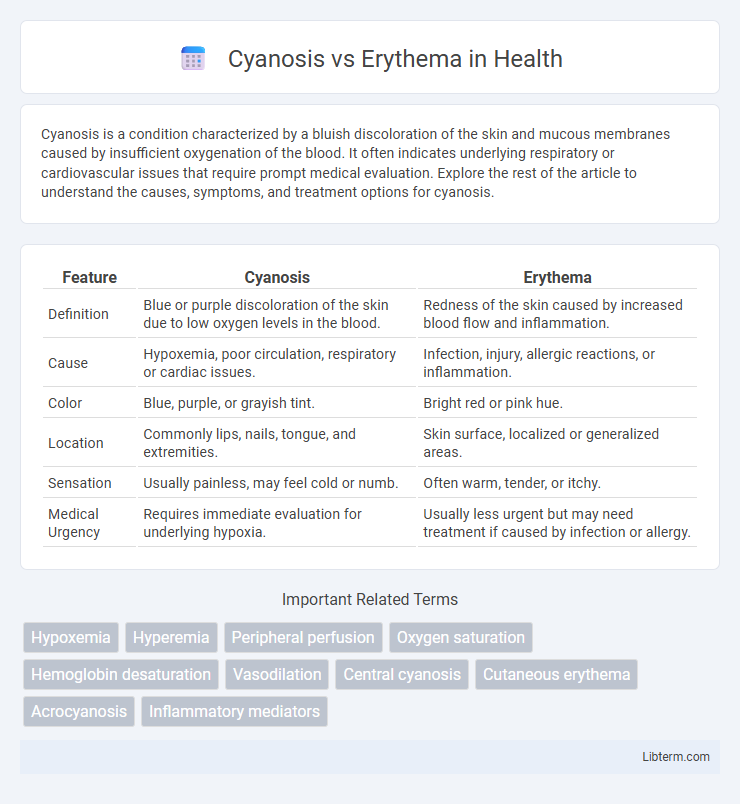Cyanosis is a condition characterized by a bluish discoloration of the skin and mucous membranes caused by insufficient oxygenation of the blood. It often indicates underlying respiratory or cardiovascular issues that require prompt medical evaluation. Explore the rest of the article to understand the causes, symptoms, and treatment options for cyanosis.
Table of Comparison
| Feature | Cyanosis | Erythema |
|---|---|---|
| Definition | Blue or purple discoloration of the skin due to low oxygen levels in the blood. | Redness of the skin caused by increased blood flow and inflammation. |
| Cause | Hypoxemia, poor circulation, respiratory or cardiac issues. | Infection, injury, allergic reactions, or inflammation. |
| Color | Blue, purple, or grayish tint. | Bright red or pink hue. |
| Location | Commonly lips, nails, tongue, and extremities. | Skin surface, localized or generalized areas. |
| Sensation | Usually painless, may feel cold or numb. | Often warm, tender, or itchy. |
| Medical Urgency | Requires immediate evaluation for underlying hypoxia. | Usually less urgent but may need treatment if caused by infection or allergy. |
Introduction to Cyanosis and Erythema
Cyanosis is a clinical sign characterized by a bluish discoloration of the skin and mucous membranes due to insufficient oxygen in the bloodstream, often indicating underlying respiratory or cardiovascular conditions. Erythema presents as redness of the skin caused by increased blood flow to the superficial capillaries, commonly resulting from inflammation, infection, or irritation. Both phenomena serve as important diagnostic indicators reflecting different pathophysiological processes affecting skin appearance and systemic health.
Definition and Overview
Cyanosis is a medical condition characterized by a bluish discoloration of the skin and mucous membranes due to low oxygen levels in the blood. Erythema refers to redness of the skin caused by increased blood flow in superficial capillaries, often resulting from inflammation or irritation. Both conditions serve as important clinical indicators, with cyanosis signaling potential hypoxemia and erythema indicating localized skin response.
Pathophysiology of Cyanosis
Cyanosis results from increased deoxygenated hemoglobin in the blood, causing a bluish discoloration of the skin and mucous membranes due to hypoxemia or impaired oxygen delivery. The pathophysiology involves reduced arterial oxygen saturation or abnormal hemoglobin derivatives, leading to tissue hypoxia. Erythema, in contrast, is characterized by redness caused by vasodilation and increased blood flow, primarily linked to inflammation or infection.
Pathophysiology of Erythema
Erythema results from increased blood flow in the superficial capillaries of the skin, often due to inflammation, infection, or thermal injury causing vasodilation and increased permeability. The pathophysiology involves the release of inflammatory mediators such as histamine, prostaglandins, and cytokines, which trigger endothelial cell relaxation and vascular smooth muscle dilation. This increased blood volume in the affected area leads to the characteristic redness and warmth seen in erythema.
Key Clinical Differences
Cyanosis presents as a blue or purple discoloration of the skin and mucous membranes caused by decreased oxygen saturation in the blood, often indicating hypoxemia or impaired circulation. Erythema manifests as redness of the skin due to increased blood flow in superficial capillaries, typically associated with inflammation, infection, or allergic reactions. Key clinical differences include the color change (blue in cyanosis vs red in erythema), underlying causes (oxygen deficiency vs vascular dilation), and associated symptoms such as cold skin or respiratory distress in cyanosis versus warmth and swelling in erythema.
Causes and Risk Factors
Cyanosis arises from inadequate oxygenation of the blood, commonly caused by respiratory or cardiovascular disorders such as chronic obstructive pulmonary disease (COPD), congestive heart failure, or congenital heart defects. Erythema results from increased blood flow to the skin, often triggered by inflammation, infection, allergic reactions, or dermatologic conditions like rosacea and contact dermatitis. Risk factors for cyanosis include chronic lung disease, smoking, and exposure to high altitudes, whereas erythema risk factors encompass sunburn, autoimmune diseases, and prolonged skin irritation.
Diagnostic Approaches
Cyanosis diagnosis involves pulse oximetry, arterial blood gas analysis to detect hypoxemia, and clinical examination for bluish skin discoloration. Erythema assessment relies on visual inspection for redness, dermoscopy, and sometimes skin biopsy to identify inflammatory or infectious causes. Differentiating these conditions requires understanding underlying causes, with cyanosis indicating oxygen deprivation and erythema reflecting inflammation or vascular changes.
Associated Symptoms
Cyanosis is characterized by a bluish discoloration of the skin and mucous membranes, often accompanied by symptoms such as shortness of breath, cold extremities, and fatigue, indicating underlying hypoxemia or poor oxygenation. Erythema presents as redness of the skin, frequently associated with warmth, swelling, tenderness, and itching, reflecting inflammation or infection in the affected area. Both conditions may signal serious medical issues, but their associated symptoms help differentiate hypoxic states from inflammatory or allergic reactions.
Treatment and Management Options
Cyanosis treatment centers on addressing the underlying causes such as hypoxemia, with oxygen therapy and management of respiratory or cardiac disorders being primary interventions. Erythema management involves identifying and treating the root cause, often through topical or systemic anti-inflammatory agents, antibiotics for infections, or avoiding irritants and allergens. Both conditions may require supportive care, but tailored treatment is essential for effective resolution based on clinical evaluation.
When to Seek Medical Attention
Seek medical attention for cyanosis immediately if you notice bluish discoloration of the lips, fingers, or toes, especially accompanied by difficulty breathing, chest pain, or confusion, as it may indicate underlying hypoxia or serious cardiopulmonary issues. Erythema requires prompt evaluation if redness is spreading rapidly, occurs with swelling, warmth, fever, or pain, suggesting possible infections like cellulitis or inflammatory conditions needing urgent treatment. Early diagnosis and management are crucial to prevent complications associated with both cyanosis and erythema.
Cyanosis Infographic

 libterm.com
libterm.com